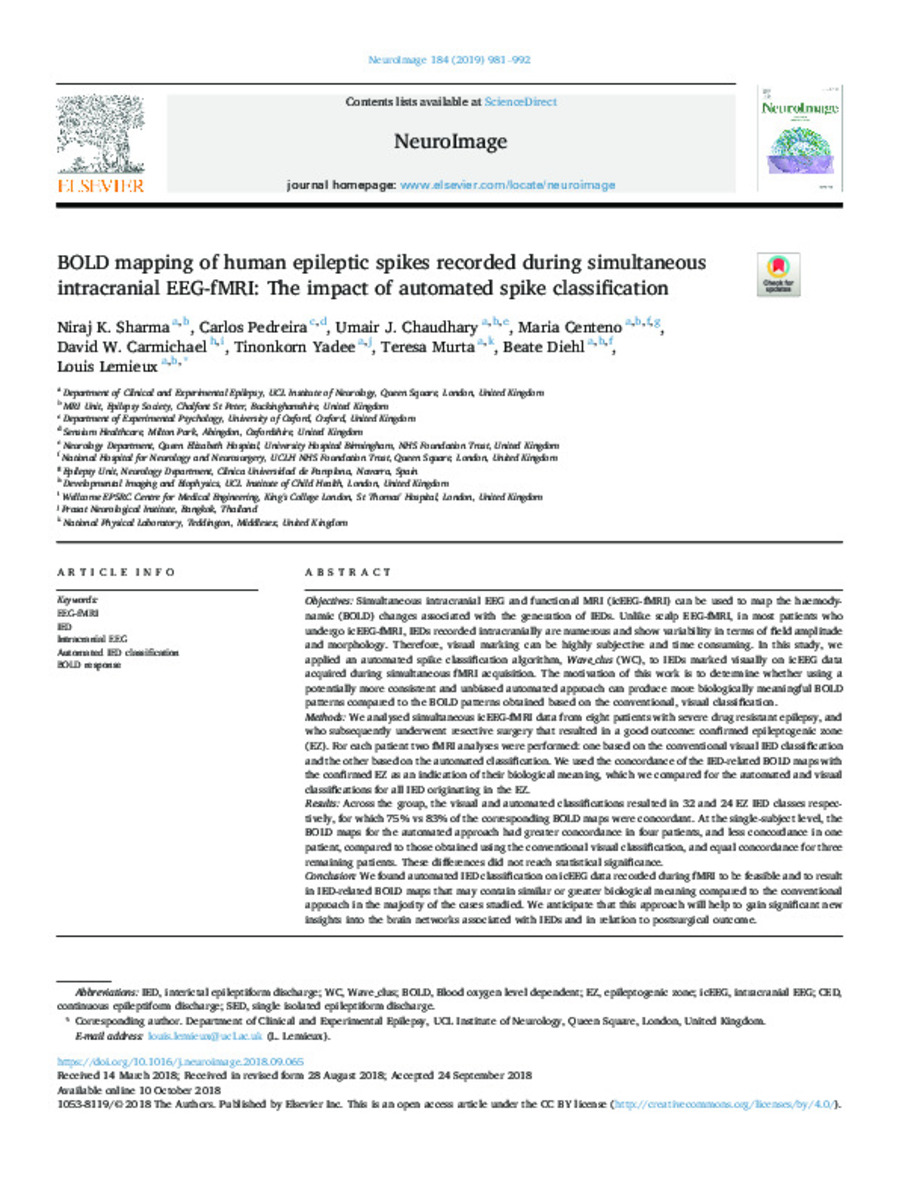Full metadata record
| DC Field | Value | Language |
|---|---|---|
| dc.creator | Sharma, N.K. (Niraj K.) | - |
| dc.creator | Pedreira, C.E. (Carlos E.) | - |
| dc.creator | Chaudhary, U.J. (Umair J.) | - |
| dc.creator | Centeno, M. (María) | - |
| dc.creator | Carmichael, D.W. (David W.) | - |
| dc.creator | Yadee, T. (Tinonkorn) | - |
| dc.creator | Murta, T. (Teresa) | - |
| dc.creator | Diehl, B. (Beate) | - |
| dc.creator | Lemieux, L. (Louis) | - |
| dc.date.accessioned | 2021-10-01T13:22:08Z | - |
| dc.date.available | 2021-10-01T13:22:08Z | - |
| dc.date.issued | 2019 | - |
| dc.identifier.citation | Sharma, N.K. (Niraj K.); Pedreira, C. (Carlos); Chaudhary, U.J. (Umair J.); et al. "BOLD mapping of human epileptic spikes recorded during simultaneous intracranial EEG-fMRI: The impact of automated spike classification". NeuroImage. 184, 2019, 981 - 992 | es |
| dc.identifier.issn | 1053-8119 | - |
| dc.identifier.other | PMID: 30315907 | - |
| dc.identifier.uri | https://hdl.handle.net/10171/62130 | - |
| dc.description.abstract | Objectives: Simultaneous intracranial EEG and functional MRI (icEEG-fMRI) can be used to map the haemodynamic (BOLD) changes associated with the generation of IEDs. Unlike scalp EEG-fMRI, in most patients who undergo icEEG-fMRI, IEDs recorded intracranially are numerous and show variability in terms of field amplitude and morphology. Therefore, visual marking can be highly subjective and time consuming. In this study, we applied an automated spike classification algorithm, Wave_clus (WC), to IEDs marked visually on icEEG data acquired during simultaneous fMRI acquisition. The motivation of this work is to determine whether using a potentially more consistent and unbiased automated approach can produce more biologically meaningful BOLD patterns compared to the BOLD patterns obtained based on the conventional, visual classification. Methods: We analysed simultaneous icEEG-fMRI data from eight patients with severe drug resistant epilepsy, and who subsequently underwent resective surgery that resulted in a good outcome: confirmed epileptogenic zone (EZ). For each patient two fMRI analyses were performed: one based on the conventional visual IED classification and the other based on the automated classification. We used the concordance of the IED-related BOLD maps with the confirmed EZ as an indication of their biological meaning, which we compared for the automated and visual classifications for all IED originating in the EZ. Results: Across the group, the visual and automated classifications resulted in 32 and 24 EZ IED classes respectively, for which 75% vs 83% of the corresponding BOLD maps were concordant. At the single-subject level, the BOLD maps for the automated approach had greater concordance in four patients, and less concordance in one patient, compared to those obtained using the conventional visual classification, and equal concordance for three remaining patients. These differences did not reach statistical significance. Conclusion: We found automated IED classification on icEEG data recorded during fMRI to be feasible and to result in IED-related BOLD maps that may contain similar or greater biological meaning compared to the conventional approach in the majority of the cases studied. We anticipate that this approach will help to gain significant new insights into the brain networks associated with IEDs and in relation to postsurgical outcome. | es_ES |
| dc.description.sponsorship | This research was conducted based on the support of The Medical Research Council, United Kingdom, grant G0301067 (LL); The Wellcome Trust, United Kingdom, grant 101092/Z/13/Z (CP) and National Institute for Health Research UCL Hospitals Biomedical Research Centre, United Kingdom. | es_ES |
| dc.language.iso | eng | es_ES |
| dc.publisher | Elsevier BV | es_ES |
| dc.relation | info:eu-repo/grantAgreement/WT/Cognitive Neuroscience and Mental Health/101092 | - |
| dc.relation | info:eu-repo/grantAgreement/MRC/UKRI/G0301067/GB/MR Imaging of Brain Generators in Human Epilepsy// | - |
| dc.rights | info:eu-repo/semantics/openAccess | es_ES |
| dc.subject | Materias Investigacion::Ciencias de la Salud::Neurología | es_ES |
| dc.subject | Automated IED classification | es_ES |
| dc.subject | BOLD response | es_ES |
| dc.subject | EEG-fMRI | es_ES |
| dc.subject | Intracranial EEG | es_ES |
| dc.subject | IED | es_ES |
| dc.title | BOLD mapping of human epileptic spikes recorded during simultaneous intracranial EEG-fMRI: The impact of automated spike classification | es_ES |
| dc.type | info:eu-repo/semantics/article | es_ES |
| dc.description.note | This is an open access article under the CC BY license (http://creativecommons.org/licenses/by/4.0/). | es_ES |
| dc.identifier.doi | 10.1016/j.neuroimage.2018.09.065 | - |
| dadun.citation.endingPage | 992 | es_ES |
| dadun.citation.publicationName | NeuroImage | es_ES |
| dadun.citation.startingPage | 981 | es_ES |
| dadun.citation.volume | 184 | es_ES |
Files in This Item:
Statistics and impact
Items in Dadun are protected by copyright, with all rights reserved, unless otherwise indicated.






